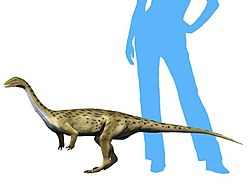Classification
In 2010, Martin Ezcurra defined the subfamily Saturnaliinae for the clade containing Saturnalia and Chromogisaurus , which were found to be close relatives in several studies. [1] While they are sometimes found to be a subgroup within the Guaibasauridae, [1] all recent studies have found the saturnaliines to form an independent lineage at the very base of the sauropodomorph family tree. [3] [4] [5] [6] [7] [8] [9] At one point, Agnosphitys was recovered as a possible saturnaliine until it was recovered as a member of Silesauridae in 2017. [10] Langer and colleagues (2019) recovered Pampadromaeus and Panphagia as relatives of Saturnalia and Chromogisaurus, elevating Saturnaliinae to family rank as Saturnaliidae. In that particular paper, they recovered Guaibasaurus as a basal theropod. [11]
Additionally, Eoraptor , Buriolestes , Bagualosaurus and especially Nhandumirim are also possible members of this clade following their position in many recent phylogenetic analyses [4] [5] [6] [7] [8] [9] and the new definition given by Langer et al. (2019), as "the maximal sauropodomorph clade to encompass Saturnalia but not Plateosaurus ." [11] In several of these analyses, Guaibasaurus is recovered as distantly related to Saturnalia, sometimes as a more basal sauropodomorph or saurischian, and in some cases specifically related to more derived taxa such as Macrocollum and Unaysaurus. This way a Guaibasauridae including Saturnalia and kin is no longer being supported.
This page is based on this
Wikipedia article Text is available under the
CC BY-SA 4.0 license; additional terms may apply.
Images, videos and audio are available under their respective licenses.












